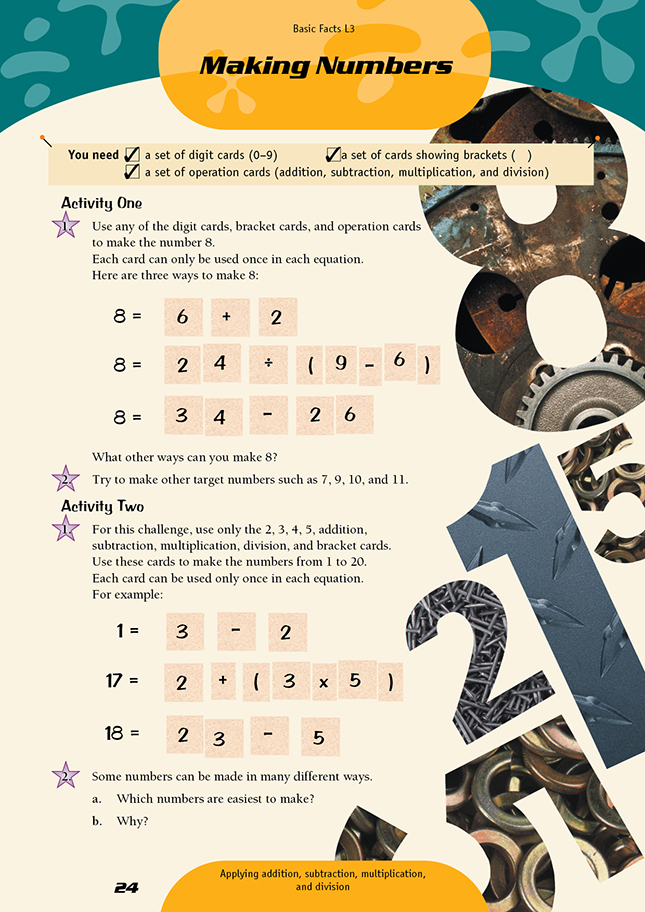This is a level 3 number activity from the Figure It Out series.
Click on the image to enlarge it. Click again to close. Download PDF (161 KB)
write equations using combinations of operations
- FIO, Level 3, Basic Facts, Making Numbers, page 24
- Numeral cards
- A set of cards showing brackets ( )
- A set of operation cards (addition, subtraction, multiplication, division)
Activities One and Two
On this page, students are required to use various combinations of numbers and operations to make a target value. Encourage them to use more than one operation in their equations. Have them keep a record of their equations so that they can compare with others and challenge each other as to how many operations they can think of.
Students have the opportunity to use brackets. You may need to explain that this is an important symbol used by mathematicians to designate the order of operations. Students may decide to use their calculators as they try out different combinations, so this may be a good time to discuss the results that different calculators give. For example, if is keyed into a scientific calculator, it will give 25, that is, 5 + (8 x 3) – 4, whereas some four-function calculators may give 35, that is, (5 + 8) x 3 – 4. A scientific calculator automatically follows the conventions for operations, that is, multiplication and division are calculated before addition and subtraction.
Answers to Activities
Activity One
Answers will vary.
Activity Two
1. Answers will vary. Possible equations include:
1 = 3 – 2, 1 = 5 – 4, 1 = 4 – 3, 1 = 2 x 3 – 5
2 = 4 – 2, 2 = 5 – 3, 2 = 4 ÷ 2, 2 = 2 x 3 – 4,
2 = 3 + 4 – 5
3 = 5 – 2, 3 = 2 x 4 – 5, 3 = 2 x 5 – (3 + 4), 3 = 5 – (4 ÷ 2), 3 = (5 + 4) ÷ 3
4 = 3 + 5 – 4, 4 = 5 + 2 – 3, 4 = (3 + 5) ÷ 2,
4 = (5 – 3) x 2
5 = 3 + 2, 5 = 2 x 4 – 3, 5 = 3 + 4 – 2
6 = 2 x 3, 6 = (4 x 3) ÷ 2, 6 = 2 x 5 – 4, 6 = 3 + 5 – 2, 6 = (5 – 3) + 4, 6 = (5 + 4) – 3
7 = 3 + 4, 7 = 3 x 4 – 5, 7 = 2 x 3 + (5 – 4), 7 = 5 + 2
8 = 2 x 4, 8 = 32 ÷ 4, 8 = 24 ÷ 3, 8 = 5 + 3, 8 = (5 – 3) x 4
9 = 4 + 5, 9 = 54 ÷ (2 x 3), 9 = 52 – 43, 9 = (5 – 2) x 3
10 = 2 x 5, 10 = 2 x 3 + 4, 10 = (4 x 5) ÷ 2, 10 = 5 x 4 ÷ 2
11 = 3 x 5 – 4, 11 = 2 x 5 + (4 – 3), 11 = 35 – 24, 11 = 53 – 42
12 = 3 x 4, 12 = (5 – 2) x 4
13 = 3 x 5 – 2, 13 = 52 ÷ 4, 13 = 45 – 32, 13 = 2 x 5 + 3, 13 = 2 x 4 + 5
14 = 3 x 4 + 2, 14 = 42 ÷ 3, 14 = 2 x 5 + 4
15 = 3 x 5
16 = (3 + 5) x 2
17 = 4 x 5 – 3, 17 = 34 ÷ 2, 17 = 3 x 4 + 5, 17 = 3 x 5 + 2
18 = 4 x 5 – 2, 18 = 54 ÷ 3
19 = 3 x 5 + 4, 19 = 24 – 5, 19 = 23 – 4, 19 = 5 x 4 – 3 + 2
20 = 4 x 5
2. Answers will vary. It could be argued that the easiest numbers to make are the ones with the most possible equations.
